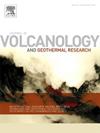Lava flow field development and lava tube formation during the 1858–1861 eruption of Vesuvius (Italy), unravelled by historical documentation, lidar data and 3D mapping
IF 2.4
3区 地球科学
Q2 GEOSCIENCES, MULTIDISCIPLINARY
Journal of Volcanology and Geothermal Research
Pub Date : 2024-09-29
DOI:10.1016/j.jvolgeores.2024.108197
引用次数: 0
Abstract
Somma-Vesuvius is well known for its powerful Plinian explosive eruptions, however during the last eruptive cycle (1631–1944), persistent activity took place on the stratovolcano as mild and violent Strombolian, and effusive eruptions, forming more than one hundred lava flow fields. An important mechanism of lava transport within lava flow fields is the formation and development of lava tubes. The presence of lava tubes in a flow field can greatly increase their distance of emplacement. Observations of lava tubes at Vesuvius have been documented in historical records and speleological reports but no modern scientific studies are available. This work focuses on lava tubes formed in the compound lava flow field of the long-lived 1858 eruption (from 27 May 1858 to 12 April 1861) that was fed by seven eruptive fissures. The temporal and spatial evolution of the 1858 lava flow field was reconstructed using historical documentation. The exposed lava flow field surface was analysed using a 1-m resolution lidar Digital Surface Model (DSM). Surveys to fully digitize the interior and the overlying surface of the largest lava tube found in the 1858 lava flow field were conducted using a terrestrial laser scanner, optical cameras, and an Unmanned Aerial Vehicle (UAV). The accurate 3D model obtained was used to precisely quantify the inner dimensions and to better constrain the morphologies of the lava tube. Observed internal features were described and used to gain information on the formation and activity of the lava tube. Our data allowed us to understand that the described lava tube formed as an inflated lava flow inside which lava flowed through during an extended period ultimately draining out completely at the end of the eruption. Understanding how lava flow fields develop and how lava tubes form on Vesuvius is crucial to re-evaluate the last effusive activity of the volcano and its impact on hazard assessment.
通过历史文献、激光雷达数据和三维测绘揭示维苏威火山(意大利)1858-1861 年喷发期间熔岩流场的发展和熔岩管的形成
索马-维苏威火山以其强大的普利尼爆炸性喷发而闻名,但在上一个喷发周期(1631-1944 年),该平流火山持续发生轻微和剧烈的血栓性喷发和喷出性喷发活动,形成了一百多个熔岩流场。熔岩流场内熔岩输送的一个重要机制是熔岩管的形成和发展。熔岩流场中熔岩管的存在会大大增加其喷发距离。在维苏威火山观察到的熔岩管在历史记录和洞穴学报告中都有记载,但没有现代的科学研究。这项研究的重点是在 1858 年长期喷发(1858 年 5 月 27 日至 1861 年 4 月 12 日)的复合熔岩流场中形成的熔岩管,该熔岩流场由七条喷发裂缝注入。利用历史文献重建了 1858 年熔岩流场的时空演变。利用 1 米分辨率的激光雷达数字地表模型(DSM)对暴露的熔岩流场表面进行了分析。利用地面激光扫描仪、光学照相机和无人飞行器(UAV)对 1858 年熔岩流场中发现的最大熔岩管的内部和上覆表面进行了全面数字化勘测。获得的精确三维模型用于精确量化熔岩管的内部尺寸,并更好地约束熔岩管的形态。我们对观察到的内部特征进行了描述,并利用这些特征获得了有关熔岩管形成和活动的信息。我们的数据让我们了解到,所描述的熔岩管是作为一个膨胀的熔岩流形成的,熔岩在很长一段时间内流经熔岩管,最终在喷发结束时完全排出。了解维苏威火山上的熔岩流场是如何形成的以及熔岩管是如何形成的,对于重新评估该火山最后一次喷发活动及其对危害评估的影响至关重要。
本文章由计算机程序翻译,如有差异,请以英文原文为准。
求助全文
约1分钟内获得全文
求助全文
来源期刊
CiteScore
5.90
自引率
13.80%
发文量
183
审稿时长
19.7 weeks
期刊介绍:
An international research journal with focus on volcanic and geothermal processes and their impact on the environment and society.
Submission of papers covering the following aspects of volcanology and geothermal research are encouraged:
(1) Geological aspects of volcanic systems: volcano stratigraphy, structure and tectonic influence; eruptive history; evolution of volcanic landforms; eruption style and progress; dispersal patterns of lava and ash; analysis of real-time eruption observations.
(2) Geochemical and petrological aspects of volcanic rocks: magma genesis and evolution; crystallization; volatile compositions, solubility, and degassing; volcanic petrography and textural analysis.
(3) Hydrology, geochemistry and measurement of volcanic and hydrothermal fluids: volcanic gas emissions; fumaroles and springs; crater lakes; hydrothermal mineralization.
(4) Geophysical aspects of volcanic systems: physical properties of volcanic rocks and magmas; heat flow studies; volcano seismology, geodesy and remote sensing.
(5) Computational modeling and experimental simulation of magmatic and hydrothermal processes: eruption dynamics; magma transport and storage; plume dynamics and ash dispersal; lava flow dynamics; hydrothermal fluid flow; thermodynamics of aqueous fluids and melts.
(6) Volcano hazard and risk research: hazard zonation methodology, development of forecasting tools; assessment techniques for vulnerability and impact.

 求助内容:
求助内容: 应助结果提醒方式:
应助结果提醒方式:


